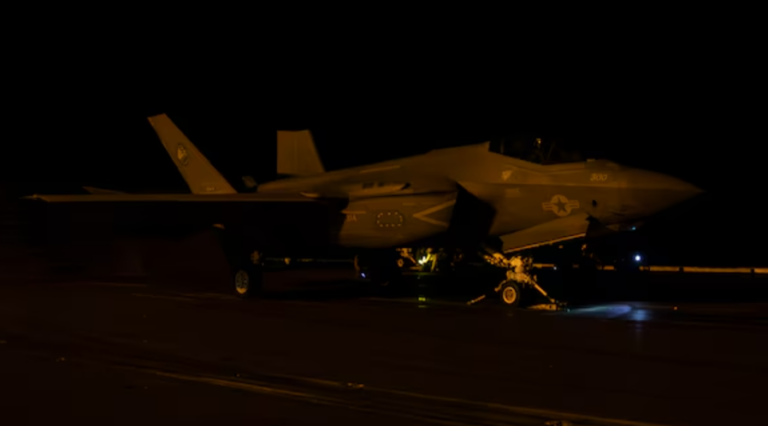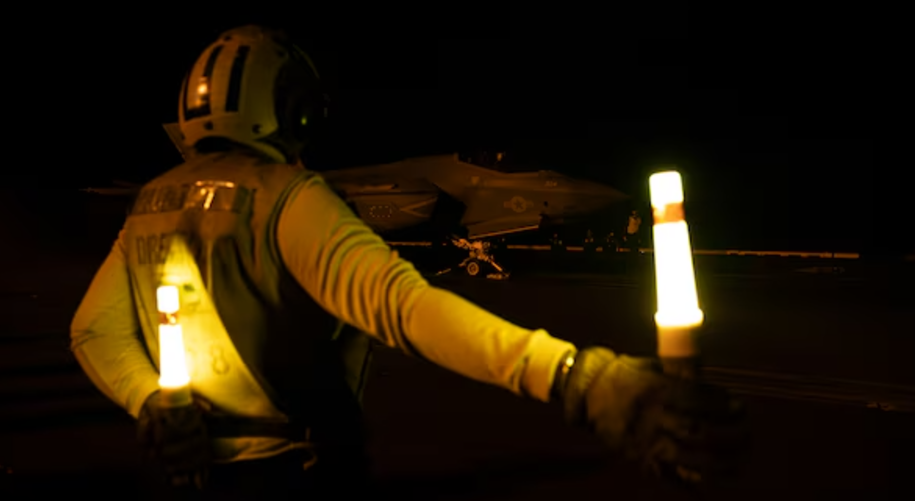U.S. Marine Squadron conducts first F-35C combat air strikes - Naval Today
 |
| Bab al Mandab - Gateway to Red Sea from Gulf of Aden, between Yemen and Djibouti |
Central Command forces executed a series of precise air strikes November 9 through 10 on multiple Houthi weapon storage facilities situated within Houthi controlled territories in Yemen. These facilities housed a variety of advanced conventional weapons used by the Iran-backed Houthis to target US and international military and civilian vessels navigating international waters in the Red Sea and Gulf of Aiden. The operation involved US Air Force and US Navy assets including F-35C fighter aircraft. This targeted operation was conducted in response to the Houthi repeated and unlawful attacks on International commercial shipping as well as us Coalition and Merchant vessels in the Red Sea, Bab al Mandab straight, and the Gulf of Aiden it also aimed to degrade the Houthi ability to threaten Regional Partners.
Marine Corps Makes History: F-35Cs Conduct First Combat Strikes Against Houthi Targets
In a historic military operation, U.S. Marine Corps F-35C Lightning II fighters have conducted their first-ever combat strikes, targeting Houthi weapons storage facilities in Yemen. The missions, carried out on November 9-10, 2024, were executed by the "Black Knights" of Marine Fighter Attack Squadron (VMFA) 314, operating from the USS Abraham Lincoln aircraft carrier.
The strikes focused on facilities housing conventional weapons, including anti-ship missiles that Iranian-backed Houthi forces had been using to threaten international shipping in the Red Sea and Gulf of Aden. Lieutenant Colonel Jeffrey "Wiki" Davis, commanding officer of VMFA-314, highlighted the aircraft's effectiveness, noting that the F-35C "demonstrated its warfighting advantage by transiting contested airspace and striking targets in the heart of Houthi territory."
The operation marks a significant milestone for the Marine Corps, as VMFA-314 is currently the only Marine squadron operating the carrier-capable F-35C variant. The squadron, based out of Marine Corps Air Station Miramar, California, transitioned from F-18 fighters to the F-35C in 2020, maintaining their tradition of pioneering new aircraft for the Marines.
"The offensive and defensive capabilities of the F-35C absolutely enhance our air wing's striking arm," said Captain Gerald "Dutch" Tritz, commander of Carrier Air Wing 9. "The now battle-tested Air Wing of the Future has proven itself a game changer across all carrier air wing missions."
This deployment represents the latest chapter in the F-35 program's combat history, following previous combat debuts of the F-35B variant in 2018 and the Air Force's F-35A in 2019.
U.S. Marine Squadron conducts first F-35C combat air strikes - Naval Today
Home naval-today U.S. Marine Squadron conducts first F-35C combat air strikes
November 25, 2024, by
U.S. Marine Corps F-35C Lightning II aircraft, assigned to Marine Fighter Attack Squadron (VMFA) 314 has conducted the first F-35C combat air strikes for the platform.

VMFA 314, assigned to Carrier Air Wing (CVW) 9 aboard the Nimitz-class aircraft carrier USS Abraham Lincoln (CVN 72), conducted multiple strikes on Houthi weapons storage facilities within Houthi-controlled territories in Yemen.
The facilities housed conventional weapons, including anti-ship missiles. The Houthis used these weapons to target U.S. and international military and civilian vessels navigating international waters in the Red Sea and Gulf of Aden.
The F-35C is a fifth-generation, long-range stealth fighter jet used by the U.S. Navy, Marine Corps and Air Force.

It is a multi-role aircraft able to perform a variety of missions, including air-to-air combat, air-to-ground strikes, reconnaissance and electronic warfare.
“The offensive and defensive capabilities of the F-35C absolutely enhance our air wing’s striking arm,” said Capt. Gerald “Dutch” Tritz, commander, CVW 9.
Other variants of the aircraft include the F-35A and the F-35B. The F-35B first saw combat in 2018 when units assigned to the Essex Amphibious Ready Group conducted airstrikes against the Taliban in Afghanistan and ISIS in Syria.
Air Force F-35A’s first combat mission was completed the year after against ISIS targets in Iraq.
VMFA 314, part of 3rd Marine Aircraft Wing, is the only deployed F-35C squadron in the Marine Corps.
Exclusive: US Marine Corps F-35C Conducts First Combat Strikes from USS Abraham Lincoln in Yemen
The U.S. Navy has confirmed a significant milestone in naval aviation, announcing that Marine Corps F-35C
Lightning II aircraft, operated by Marine Fighter Attack Squadron
(VMFA) 314, executed their first combat airstrikes from the aircraft
carrier USS Abraham Lincoln (CVN 72). The strikes, conducted on November
9-10, 2024, targeted Iran-backed Houthi forces in Yemen and marked a
critical deployment of the F-35C aircraft carrier-based variant in the
F-35 stealth fighter family.
Follow Army Recognition on Google News at this link
U.S. Marine Corps F-35C Lightning II aircraft, assigned to Marine Fighter Attack Squadron (VMFA) 314 conducted the first F-35C combat air strikes from the aircraft carrier USS Abraham Lincoln. (Picture source: U.S. Navy)
VMFA-314, known as the "Black Knights" and operating as part of Carrier Air Wing (CVW) 9 aboard the Nimitz-class carrier, carried out precision strikes on weapons storage facilities located within Houthi-controlled territories. These facilities were used to store conventional weaponry, including anti-ship missiles, that the Houthis had employed to target both U.S. and international vessels navigating vital shipping routes in the Red Sea and Gulf of Aden. The operation was a decisive effort to degrade the Houthis’ ability to disrupt maritime traffic and ensure the security of international waters.
The F-35C Lightning II, tailored specifically for the U.S. Navy’s operational needs, is the first carrier-capable stealth fighter to enter service. As the Navy’s variant of the Joint Strike Fighter program, the F-35C features larger wings, robust landing gear, and an arrestor hook designed to handle the unique demands of carrier takeoffs and landings. With its wings folding for easier storage aboard ships, the F-35C maximizes deck space on carriers, a crucial factor for naval operations. Its longer wingspan, compared to the F-35A and F-35B variants, improves range and maneuverability, critical in missions requiring extended reach over maritime and coastal environments.
Beyond its structural enhancements, the F-35C integrates advanced avionics, sensors, and stealth technology, enabling it to perform various missions, including air-to-ground strikes, air superiority, reconnaissance, and electronic warfare. These capabilities allow the aircraft to evade sophisticated radar systems, gather real-time intelligence, and strike high-value targets with precision, making it an indispensable asset in contested environments. The aircraft's ability to link seamlessly with other assets in a carrier strike group enhances the situational awareness and lethality of the entire fleet.
For VMFA-314, this deployment represents another landmark in the history of aviation firsts. Based at Marine Corps Air Station Miramar, California, the “Black Knights” transitioned from the F/A-18 Hornet to the F-35C in 2020, becoming the first Marine Corps squadron to operate this carrier-optimized variant. The squadron’s legacy includes being the first operational Marine unit to fly both the F-4 Phantom and the F/A-18 Hornet, solidifying their reputation as innovators within Marine Corps aviation.
The recent airstrikes reflect the integration of VMFA-314 into carrier strike group operations, demonstrating their readiness and the operational maturity of the F-35C platform. The strikes also underline the strategic importance of the Red Sea and Gulf of Aden, which serve as vital corridors for global trade. Iran-backed Houthi forces have increasingly used advanced weaponry, including missiles and drones, to threaten these shipping lanes, escalating regional tensions. By targeting the Houthis’ weapon storage facilities, the U.S. military aims to deter further aggression and ensure the free flow of commerce through these critical waterways.
The deployment of the F-35C aboard the USS *Abraham Lincoln* highlights the U.S. military’s ability to project power and respond rapidly to emerging threats. As the only Marine Corps squadron currently flying the F-35C, VMFA-314 has proven its capability to integrate with Navy carrier air wings, underscoring the versatility and combat effectiveness of this advanced aircraft in safeguarding U.S. and allied interests in the region.
This mission, marking the first combat use of the F-35C by Marine Corps forces, showcases the synergy between cutting-edge technology and tactical execution, reaffirming the U.S. Navy and Marine Corps role as global leaders in maritime security and power projection.
U.S. Marine Squadron Conduct First Combat Strikes Using F-35C Platform
U.S. CENTRAL COMMAND AREA OF RESPONSIBILITY --
U.S. Marine Corps F-35C Lightning II aircraft, assigned to Marine Fighter Attack Squadron (VMFA) 314, conducted the first F-35C combat air strikes for the platform, Nov. 9-10.
VMFA 314, assigned to Carrier Air Wing (CVW) 9 aboard the Nimitz-class aircraft carrier USS Abraham Lincoln (CVN 72), conducted multiple strikes on Houthi weapons storage facilities within Houthi-controlled territories in Yemen. The facilities housed conventional weapons, including anti-ship missiles. The Iranian-backed Houthis used these weapons to target U.S. and international military and civilian vessels navigating international waters in the Red Sea and Gulf of Aden.
“The F-35C demonstrated its warfighting advantage by transiting contested airspace and striking targets in the heart of Houthi territory over multiple days,” stated Lt. Col. Jeffrey "Wiki" Davis, commanding officer of VMFA-314. “My Marines are honored to be first to fight with the F-35C.”
The F-35C is a fifth-generation, long-range stealth fighter jet used by the U.S. Navy, Marine Corps and Air Force, and is a multi-role aircraft able to perform a variety of missions, including air-to-air combat, air-to-ground strikes, reconnaissance and electronic warfare.
"The offensive and defensive capabilities of the F-35C absolutely enhance our air wing's striking arm," said Capt. Gerald "Dutch" Tritz, commander, CVW 9. "The now battle-tested Air Wing of the Future has proven itself a game changer across all carrier air wing missions."
Other variants of the aircraft include the F-35A and the F-35B. The F-35B first saw combat in 2018 when units assigned to the Essex Amphibious Ready Group conducted airstrikes against the Taliban in Afghanistan and ISIS in Syria. Air Force F-35A’s first combat mission was completed the year after against ISIS targets in Iraq.
The “Black Knights” of VMFA-314, based out of Miramar, Calif., transitioned from the F-18 to the F-35C in 2020, making them the first fleet squadron in both the Navy and Marine Corps to operate the 5th Generation fighter aircraft. VMFA 314 was also the first operational Marine squadron to fly the F-4 Phantom and F-18 Hornet.
VMFA 314, part of 3rd Marine Aircraft Wing, is the only deployed F-35C squadron in the Marine Corps.

Comments
Post a Comment